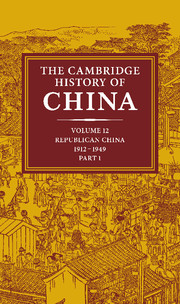Crossref Citations
This Book has been
cited by the following publications. This list is generated based on data provided by Crossref.
Fitzgerald, John
1990.
The Misconceived Revolution: State and Society in China's Nationalist Revolution, 1923–26.
The Journal of Asian Studies,
Vol. 49,
Issue. 2,
p.
323.
Wasserstrom, Jeffrey N.
1992.
Towards a social history of the Chinese revolution: A review: Part 1 : The evolution of a field1.
Social History,
Vol. 17,
Issue. 1,
p.
1.
He, Ping
1995.
Perception of identity in Modern China.
Social Identities,
Vol. 1,
Issue. 1,
p.
127.
Skřivan, Aleš
2005.
Economic Aspects of Forming Communist Regime in China during the First Years of its Existence.
Acta Oeconomica Pragensia,
Vol. 13,
Issue. 3,
p.
109.
2007.
China's Republic.
p.
1.
Rousset, Pierre
2009.
The International Encyclopedia of Revolution and Protest.
p.
1.
Will, Pierre-Étienne
2010.
Citadins et citoyens dans la Chine du xxe siècle.
p.
353.
Deng, Kent
and
O'Brien, Patrick
2016.
Establishing statistical foundations of a chronology for the great divergence: a survey and critique of the primary sources for the construction of relative wage levels for Ming–Qing China.
The Economic History Review,
Vol. 69,
Issue. 4,
p.
1057.
2016.
Postcolonialism.
p.
432.
Yu, Jianxing
2019.
The Palgrave Handbook of Local Governance in Contemporary China.
p.
1.
BECKER, BERT
2020.
The Haiphong Shipping Boycotts of 1907 and 1909–10: Business interactions in the Haiphong-Hong Kong rice shipping trade.
Modern Asian Studies,
Vol. 54,
Issue. 3,
p.
930.
Chen, Yuyu
Wang, Hui
and
Yan, Se
2022.
The long-term effects of Protestant activities in China.
Journal of Comparative Economics,
Vol. 50,
Issue. 2,
p.
394.
Sui, Qing-yuan
2022.
Money and Government.
p.
29.
Sebillaud, Pauline
Berger, Elizabeth
Hou, Kan
Gueguen, Gwendal
Jing, Zhongwei
Peixoto, Xavier
Keute, Jennifer
and
Devièse, Thibaut
2022.
Catholic-Confucian Mortuary Practices in a Rural Manchurian Cemetery.
Historical Archaeology,
Vol. 56,
Issue. 3,
p.
563.
Xu, Diheng
2023.
Interactions Between Chinese Tax Incentives and WTO’s Subsidy Rules Against the Background of EU State Aid.
p.
175.
Li, Taiheng
Zhang, Yingyi
and
Wei, Jun
2024.
The Church Museums’ Evolution of the Idea and Methods of Missionary Work in China: A Study of Tsinanfu Institute.
Religions,
Vol. 15,
Issue. 5,
p.
598.



